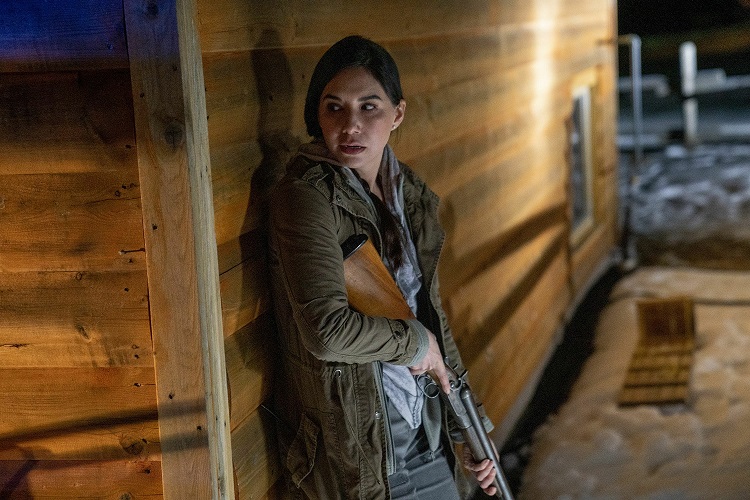Seeing as how most classic cinematic horror characters come from European myths and legends — the vampire, the werewolf, and so forth — it’s easy to forget that North America has its very own horror creature of ancient legend: the Wendigo. The creature comes from Native American roots, to be precise, stemming from the myths of the Algonquian people. While not as well-known as Dracula or the Wolf Man, the Wendigo has nonetheless been the subject of hundreds of novels, stories, television episodes and movies. Given the ambiguity and variety of the myths involving the creature, the powers and appearance of the Wendigo has wildly varied. In Larry Fessenden’s WENDIGO (2001), for instance, the creature is a half-man, half-deer shapeshifter, yet in Antonia Bird’s RAVENOUS (1999), the idea of the beast is used in a way that’s analogous to vampirism, while in the video game UNTIL DAWN (2015) the creature is presented as a possession/zombie-like plague. Perhaps this constant re-interpretation of the creature is what has kept it from becoming as cliche as the more famous horror monsters, but it’s true to the myth’s origins, as the Native Americans have many concepts and legends about what the Wendigo is, and even what name it goes by. DON’T SAY ITS NAME, a film by Cree director Rueben Martell starring a primarily Native American cast, addresses the pervasive ambiguity of the Wendigo head-on, the movie’s title an indication of its approach to the creature.

For the most part, DON’T SAY ITS NAME’s ambiguous approach to its subject matter works, creating an air of compelling mystery within the film. Like any good horror (or noir) story, the movie begins with the tragic murder of Kharis Redwater (Sheena Kaine), a native of a small northern Canadian town. A passionate activist who had been protesting the impending construction of a coal mine by a callous mining company, the circumstances of Kharis’ death already look suspicious to reservation police officer Betty (Madison Walsh). Things only get stranger from there, as a series of seemingly innocent people are brutally murdered by what appears to be a wild animal looking to feed, only the companions who had been with the victims at the time of their murder saw no animal or an assailant of any kind. After hearing the wild tales of these encounters, the members of the town begin to suspect the worst, refusing to invoke the name of the evil spirit they believe responsible but preparing to combat it nonetheless. Army veteran Stacey (Sera-Lys McArthur) and town elder Carson (Julian Black Antelope) attempt to hunt the creature while Betty follows a hunch and interrogates Kharis’ grieving mother, Mary Lynn (Carla Fox), about what exactly happened to Kharis’ corpse.
The principal issue with DON’T SAY ITS NAME is that it refuses to provide much in the way of exposition regarding its supernatural elements. While the first half of the movie holds back a great deal with regard to not just its monstrous antagonist but its leading characters and their backstories, the lack of information doesn’t become an issue until deep in the third act of the film, when Betty and Stacey are trying to stop the Wheetago (the film’s name for the Wendigo, which this writer only found within the film’s press kit) and their attempts are less exciting or scary than Martell may be trying to make them, given that it’s unclear what exactly the creature is. The movie’s conception of the Wheetago is pretty unique, making it look more like a cross between a zombie and a ghost than an animal, but the creature’s incorporeality leaves things feeling odd when, for instance, someone fires guns at it. While the script by Martell and Gerald Wexler lends the Wheetago a good amount of dramatic weight in the way the characters dance around the subject with foreboding (with seemingly the whole town of Cree aware of the legends, which is a nice touch), that set up never really pays off. There’s a thematic coherence in that choice — the secrets of the Wheetago are meant for this community only, with no outsiders privy to any privileged information — but it makes the movie’s horror aspects weaker, with the creature ending up more frustratingly vague than eerie or threatening.

Fortunately, DON’T SAY ITS NAME isn’t a movie totally reliant on its horror aspects, and as such it provides a compelling and unique experience separate from a standard creature feature. While the kill scenes and the big confrontation in the finale of the film have their moments, the majority of the movie is a noir-ish mystery, with Betty and Stacey investigating the murder of Kharis, finding buried secrets and unexpected allies and enemies in the process. Martell and his cast do a fantastic job of making the film’s ensemble feel like a tight-knit community, giving the movie that small town vibe without having to oversell it. The majority of the movie is set during the daytime, which highlights the crime thriller feel while placing it squarely in the realm of daylight horror, further enhancing the movie’s uniqueness. The most surprising element of the film is how it treats its politics and themes with remarkable nuance — it’d be easy to make a polemic about an evil major corporation messing with Native American land in a post-Keystone pipeline world, but Martell makes the film more of a debate, pointing out how some issues aren’t so clear-cut, and how damage can be done as much from within the community as without. It certainly doesn’t let its corporate characters off the hook, but it takes them out of the equation, keeping the focus solely on the members of the town rather than too many outside villainous forces.
At the core of the movie is a question of justice, with the Wendigo/Wheetago used as a force of vengeance rather than pure evil. It takes the trope of hunger and cannibalism associated with the creature and morphs it into a look at how revenge can become its own addiction, as the Wheetago separates people into sides of innocence and guilt too easily and without consideration. As Stacey vocalizes during one key scene, the idea of fighting for one’s entire life is too draining and hopeless, ultimately doing more damage to one’s self than good. The film shows how the truly guilty can be punished for their crimes without doing additional harm along the way, providing a way forward for the town as well as the people. DON’T SAY ITS NAME presents how the Cree community (and, by extension, all Native American communities) are more than capable of handling their own problems, just as Martell and his cast and crew are more than capable of making a film that stands out amongst the crowd and reimagines a traditional horror creature to boot.
Tags: Canada, Carla Fox, Catherine Gell, Douglas Munro, Fantasia Film Festival, Gerald Wexler, Hannah Duke, Horror, Julian Black Antelope, Madison Walsh, Monsters, Rueben Martell, Samuel Marty, Sera-Lys McArthur, Sheena Kaine, The Wendigo, Tom Carey, Wilma Pelly




No Comments